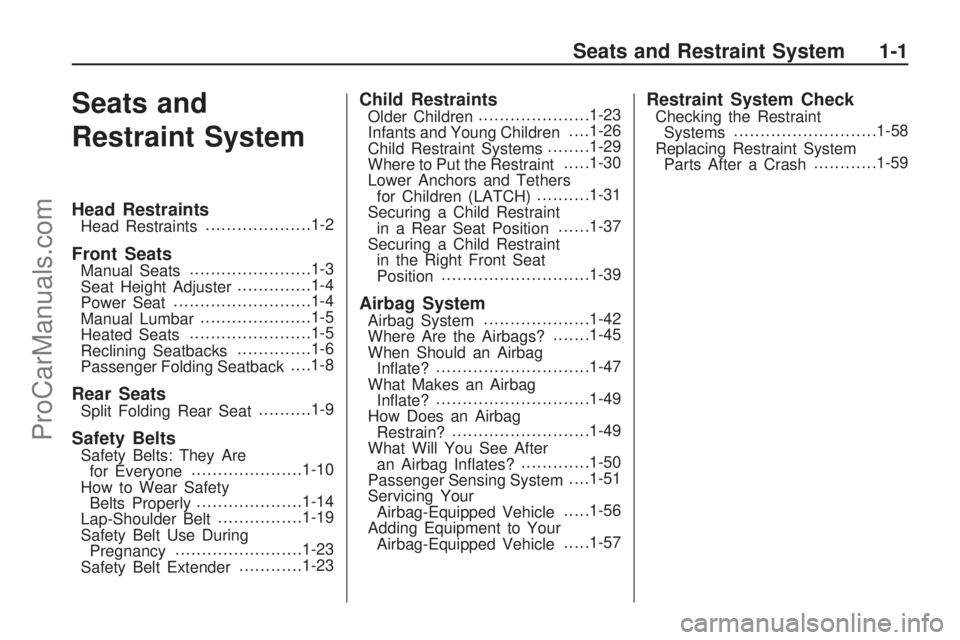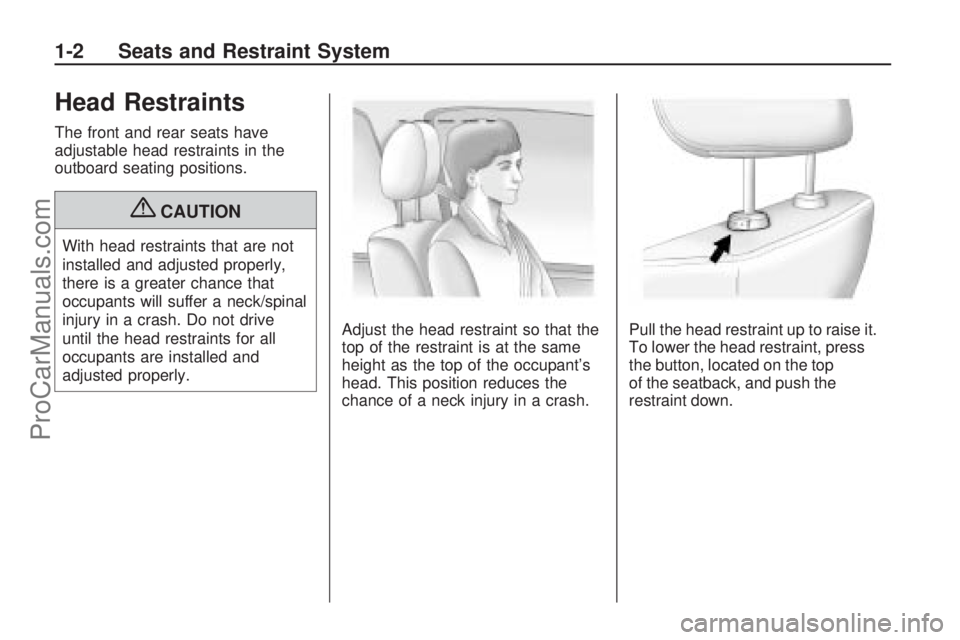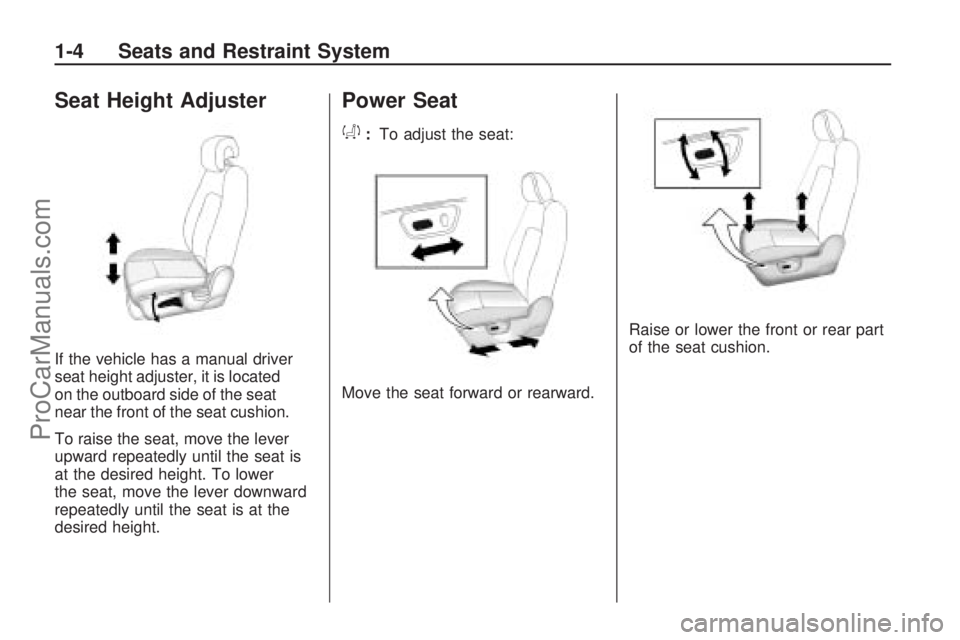height SATURN VUE 2009 Owners Manual
[x] Cancel search | Manufacturer: SATURN, Model Year: 2009, Model line: VUE, Model: SATURN VUE 2009Pages: 386, PDF Size: 2.3 MB
Page 5 of 386

Seats and
Restraint System
Head RestraintsHead Restraints....................1-2
Front SeatsManual Seats.......................1-3
Seat Height Adjuster..............1-4
Power Seat..........................1-4
Manual Lumbar.....................1-5
Heated Seats.......................1-5
Reclining Seatbacks..............1-6
Passenger Folding Seatback. . . .1-8
Rear SeatsSplit Folding Rear Seat..........1-9
Safety BeltsSafety Belts: They Are
for Everyone.....................1-10
How to Wear Safety
Belts Properly....................1-14
Lap-Shoulder Belt................1-19
Safety Belt Use During
Pregnancy........................1-23
Safety Belt Extender............1-23
Child RestraintsOlder Children.....................1-23
Infants and Young Children. . . .1-26
Child Restraint Systems........1-29
Where to Put the Restraint.....1-30
Lower Anchors and Tethers
for Children (LATCH)..........1-31
Securing a Child Restraint
in a Rear Seat Position......1-37
Securing a Child Restraint
in the Right Front Seat
Position............................1-39
Airbag SystemAirbag System....................1-42
Where Are the Airbags?.......1-45
When Should an Airbag
In�ate?.............................1-47
What Makes an Airbag
In�ate?.............................1-49
How Does an Airbag
Restrain?..........................1-49
What Will You See After
an Airbag In�ates?.............1-50
Passenger Sensing System. . . .1-51
Servicing Your
Airbag-Equipped Vehicle.....1-56
Adding Equipment to Your
Airbag-Equipped Vehicle.....1-57
Restraint System CheckChecking the Restraint
Systems...........................1-58
Replacing Restraint System
Parts After a Crash............1-59
Seats and Restraint System 1-1
ProCarManuals.com
Page 6 of 386

Head Restraints
The front and rear seats have
adjustable head restraints in the
outboard seating positions.
{CAUTION
With head restraints that are not
installed and adjusted properly,
there is a greater chance that
occupants will suffer a neck/spinal
injury in a crash. Do not drive
until the head restraints for all
occupants are installed and
adjusted properly.Adjust the head restraint so that the
top of the restraint is at the same
height as the top of the occupant’s
head. This position reduces the
chance of a neck injury in a crash.Pull the head restraint up to raise it.
To lower the head restraint, press
the button, located on the top
of the seatback, and push the
restraint down.
1-2 Seats and Restraint System
ProCarManuals.com
Page 8 of 386

Seat Height Adjuster
If the vehicle has a manual driver
seat height adjuster, it is located
on the outboard side of the seat
near the front of the seat cushion.
To raise the seat, move the lever
upward repeatedly until the seat is
at the desired height. To lower
the seat, move the lever downward
repeatedly until the seat is at the
desired height.
Power Seat
a
:To adjust the seat:
Move the seat forward or rearward.Raise or lower the front or rear part
of the seat cushion.
1-4 Seats and Restraint System
ProCarManuals.com
Page 24 of 386

4. If equipped with a shoulder belt
height adjuster, move it to the
height that is right for you.
See “Shoulder Belt Height
Adjustment” later in this section
for instructions on use and
important safety information.
5. To make the lap part tight, pull
up on the shoulder belt.
It may be necessary to pull the
stitching on the safety belt
through the latch plate to fully
tighten the lap belt on smaller
occupants.To unlatch the belt, push the button
on the buckle. The belt should return
to its stowed position. Slide the latch
plate up the safety belt webbing
when the safety belt is not in use.
The latch plate should rest on the
stitching on the safety belt, near the
guide loop on the side wall.
Before a door is closed, be sure the
safety belt is out of the way. If a
door is slammed against a safety
belt, damage can occur to both the
safety belt and the vehicle.Shoulder Belt Height Adjuster
The vehicle has a shoulder belt
height adjuster for the driver
and right front passenger seating
positions.
Adjust the height so that the
shoulder portion of the belt is
centered on the shoulder. The belt
should be away from the face and
neck, but not falling off of the
shoulder. Improper shoulder belt
height adjustment could reduce the
effectiveness of the safety belt in a
crash.
1-20 Seats and Restraint System
ProCarManuals.com
Page 25 of 386

Squeeze the release buttons (A)
together and move the height
adjuster up or down to the desired
position.
After the adjuster is set to the desired
position, try to move it up or down
without squeezing the release
buttons to make sure it has locked
into position.
Safety Belt Pretensioners
This vehicle has safety belt
pretensioners for the front outboard
occupants. Although the safety belt
pretensioners cannot be seen, theyare part of the safety belt assembly.
They can help tighten the safety belts
during the early stages of a moderate
to severe frontal, near frontal, or rear
crash if the threshold conditions for
pretensioner activation are met. And,
for vehicles with side impact airbags,
safety belt pretensioners can help
tighten the safety belts in a side
crash or a rollover event.
Pretensioners work only once. If the
pretensioners activate in a crash,
they will need to be replaced, and
probably other new parts for the
vehicle’s safety belt system. See
Replacing Restraint System Parts
After a Crash on page 1-59.
Rear Safety Belt Comfort
Guides
Rear shoulder belt comfort guides
may provide added safety belt
comfort for older children who have
outgrown booster seats and for
some adults. When installed on a
shoulder belt, the comfort guide
positions the shoulder belt away
from the neck and head.There is one guide for each
outboard passenger position in the
rear seat. Here is how to install
a comfort guide to the safety belt:
1. Remove the guide from its
storage location, which is a
pocket on the side of the seat.
2. Place the guide over the belt and
insert the two edges of the belt
into the slots of the guide.
Seats and Restraint System 1-21
ProCarManuals.com
Page 28 of 386

The manufacturer’s instructions that
come with the booster seat, state
the weight and height limitations for
that booster. Use a booster seat
with a lap-shoulder belt until
the child passes the below �t test:
Sit all the way back on the
seat. Do the knees bend at the
seat edge? If yes, continue.
If no, return to the booster seat.
Buckle the lap-shoulder belt.
Does the shoulder belt rest on the
shoulder? If yes, continue. If no,
try using the rear safety belt
comfort guide. See “Rear Safety
Belt Comfort Guides” under
Lap-Shoulder Belt on page 1-19
for more information. If the
shoulder belt still does not rest
on the shoulder, then return to
the booster seat.
Does the lap belt �t low and snug
on the hips, touching the thighs?
If yes, continue. If no, return to the
booster seat.
Can proper safety belt �t be
maintained for the length of the
trip? If yes, continue. If no, return
to the booster seat.
Q:What is the proper way to
wear safety belts?
A:An older child should wear a
lap-shoulder belt and get the
additional restraint a shoulder
belt can provide. The shoulder
belt should not cross the face
or neck. The lap belt should
�t snugly below the hips,
just touching the top of the
thighs. This applies belt force
to the child’s pelvic bones
in a crash. It should never be
worn over the abdomen,
which could cause severe or
even fatal internal injuries
in a crash.Also see “Rear Safety Belt Comfort
Guides” underLap-Shoulder Belt
on page 1-19.
According to accident statistics,
children and infants are safer when
properly restrained in a child
restraint system or infant restraint
system secured in a rear seating
position.
In a crash, children who are not
buckled up can strike other people
who are buckled up, or can be
thrown out of the vehicle. Older
children need to use safety
belts properly.
1-24 Seats and Restraint System
ProCarManuals.com
Page 32 of 386

Q:What are the different types of
add-on child restraints?
A:Add-on child restraints, which
are purchased by the vehicle’s
owner, are available in four basic
types. Selection of a particular
restraint should take into
consideration not only the child’s
weight, height, and age but also
whether or not the restraint will be
compatible with the motor vehicle
in which it will be used.
For most basic types of child
restraints, there are many
different models available.
When purchasing a child
restraint, be sure it is designed
to be used in a motor vehicle. If it
is, the restraint will have a label
saying that it meets federal motor
vehicle safety standards.
The restraint manufacturer’s
instructions that come with
the restraint state the weight andheight limitations for a particular
child restraint. In addition,
there are many kinds of restraints
available for children with
special needs.
{CAUTION
To reduce the risk of neck and
head injury during a crash, infants
need complete support. This is
because an infant’s neck is not
fully developed and its head
weighs so much compared with
the rest of its body. In a crash, an
infant in a rear-facing child
restraint settles into the restraint,
so the crash forces can be
distributed across the strongest
part of an infant’s body, the back
and shoulders. Infants should
always be secured in rear-facing
child restraints.
{CAUTION
A young child’s hip bones are still
so small that the vehicle’s regular
safety belt may not remain low on
the hip bones, as it should.
Instead, it may settle up around
the child’s abdomen. In a crash,
the belt would apply force on a
body area that is unprotected by
any bony structure. This alone
could cause serious or fatal
injuries. To reduce the risk of
serious or fatal injuries during a
crash, young children should
always be secured in appropriate
child restraints.
1-28 Seats and Restraint System
ProCarManuals.com
Page 61 of 386

Adding Equipment to
Your Airbag-Equipped
Vehicle
Q:Is there anything I might add
to or change about the
vehicle that could keep the
airbags from working
properly?
A:Yes. If you add things that
change the vehicle’s frame,
bumper system, height, front end
or side sheet metal, they may
keep the airbag system from
working properly. Changing or
moving any parts of the front
seats, safety belts, the airbag
sensing and diagnostic module,
steering wheel, instrument
panel, roof-rail airbag modules,
ceiling headliner or pillar
garnish trim, front sensors,
side impact sensors, rollover
sensor module, or airbag wiring
can affect the operation of
the airbag system.In addition, the vehicle has a
passenger sensing system for the
right front passenger position,
which includes sensors that
are part of the passenger seat.
The passenger sensing system
may not operate properly if the
original seat trim is replaced
with non-GM covers, upholstery
or trim, or with GM covers,
upholstery or trim designed for a
different vehicle. Any object, such
as an aftermarket seat heater or a
comfort enhancing pad or device,
installed under or on top of the
seat fabric, could also interfere
with the operation of the
passenger sensing system.
This could either prevent proper
deployment of the passenger
airbag(s) or prevent the
passenger sensing system from
properly turning off the passenger
airbag(s). SeePassenger
Sensing System on page 1-51.If you have questions, call
Customer Assistance. The phone
numbers and addresses for
Customer Assistance are in
Step Two of the Customer
Satisfaction Procedure in
this manual. SeeCustomer
Satisfaction Procedure on
page 7-1.
If the vehicle has rollover
roof-rail airbags, seeDifferent
Size Tires and Wheels on
page 5-59for additional
important information.
Seats and Restraint System 1-57
ProCarManuals.com
Page 277 of 386

Notice:
Using the wrong �uid can badly
damage brake hydraulic system
parts. For example, just a few
drops of mineral-based oil,
such as engine oil, in the brake
hydraulic system can damage
brake hydraulic system parts so
badly that they will have to be
replaced. Do not let someone
put in the wrong kind of �uid.
If brake �uid is spilled on the
vehicle’s painted surfaces, the
paint �nish can be damaged. Be
careful not to spill brake �uid
on the vehicle. If you do, wash it
off immediately. SeeWashing
Your Vehicle on page 5-75.
Brake Wear
This vehicle has disc brakes. Disc
brake pads have built-in wear
indicators that make a high-pitched
warning sound when the brake
pads are worn and new pads are
needed. The sound can come
and go or be heard all the time the
vehicle is moving, except when
applying the brake pedal �rmly.
{CAUTION
The brake wear warning sound
means that soon the brakes will
not work well. That could lead to
an accident. When the brake wear
warning sound is heard, have the
vehicle serviced.
Notice:Continuing to drive with
worn-out brake pads could
result in costly brake repair.Some driving conditions or climates
can cause a brake squeal when the
brakes are �rst applied or lightly
applied. This does not mean
something is wrong with the brakes.
Properly torqued wheel nuts are
necessary to help prevent
brake pulsation. When tires are
rotated, inspect brake pads for wear
and evenly tighten wheel nuts in
the proper sequence to torque
speci�cations inCapacities and
Specifications on page 5-86.
Brake linings should always be
replaced as complete axle sets.
Brake Pedal Travel
See your dealer/retailer if the brake
pedal does not return to normal
height, or if there is a rapid increase
in pedal travel. This could be a sign
that brake service might be required.
Brake Adjustment
Every time the brakes are applied,
with or without the vehicle moving,
the brakes adjust for wear.
Service and Appearance Care 5-29
ProCarManuals.com
Page 285 of 386

The vehicle should not have any
snow, ice, or mud on it.
The vehicle should be fully
assembled and all other
work stopped while headlamp
aiming is being performed.
The vehicle should be normally
loaded with a full tank of fuel and
one person or 160 lbs (75 kg)
sitting on the driver’s seat.
Tires should be properly in�ated.
Headlamp aiming is done with the
vehicle’s low-beam headlamps.
The high-beam headlamps will be
correctly aimed if the low-beam
headlamps are aimed properly.To adjust the vertical aim, do the
following:
1. Open the hood. SeeHood
Release on page 5-11for
more information.
2. Locate the aim dot on the lens of
the low-beam headlamp.
3. Measure the distance from the
ground to the aim dot on the
low-beam headlamp. Record the
distance.4. At the wall measure from the
ground upward (A) to the
recorded distance from Step 3
and mark it.
5. Draw or tape a horizontal line (B)
on the wall the width of the
vehicle at the height of the mark
in Step 4.
Service and Appearance Care 5-37
ProCarManuals.com